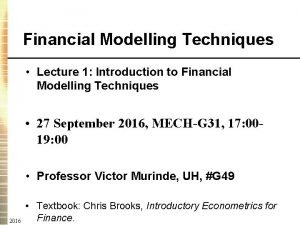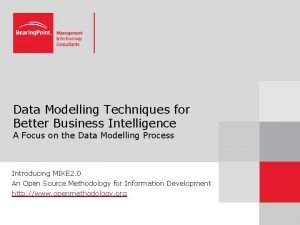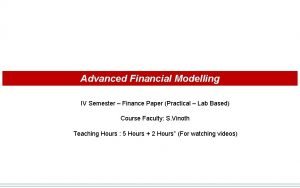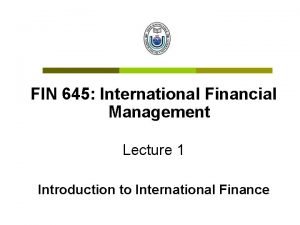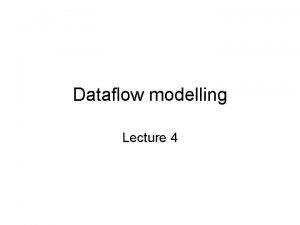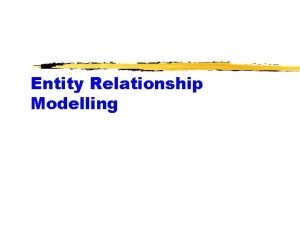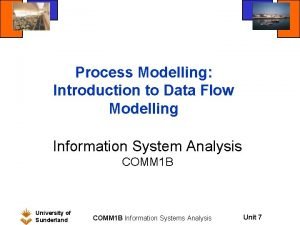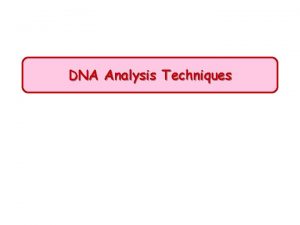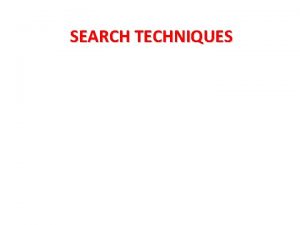Financial Modelling Techniques Lecture 1 Introduction to Financial













- Slides: 13

Financial Modelling Techniques • Lecture 1: Introduction to Financial Modelling Techniques • 27 September 2016, MECH-G 31, 17: 0019: 00 • Professor Victor Murinde, UH, #G 49 2016 • Textbook: Chris Brooks, Introductory Econometrics for Finance.

Financial Modelling Techniques? q What is financial modelling? q What are the main elements of financial modelling, in the context of this module and the MSc Financial Management? q The Odyssey: A journey through the module The Odyssey

Examples of problems in Financial Modelling 1. Testing whether financial markets are weak-form informationally efficient. 2. Measuring the volatility (risk) of bond returns. 3. Explaining the determinants of bond credit ratings used by the ratings agencies. 4. Modelling long-term relationships between stock prices and exchange rates ‘Introductory Econometrics for Finance’ © Chris Brooks 2008

What are the Special Characteristics of Financial Data? • Frequency & quantity of data Stock market prices are measured every time there is a trade or somebody posts a new quote. • Quality Recorded asset prices are usually those at which the transaction took place. No possibility for measurement error but financial data are “noisy”. ‘Introductory Econometrics for Finance’ © Chris Brooks 2008

Types of Data and Notation • There are 3 types of data which econometricians might use for analysis: 1. Time series data 2. Cross-sectional data 3. Panel data, a combination of 1. & 2. • The data may be quantitative (e. g. exchange rates, stock prices, number of shares outstanding), or qualitative (e. g. day of the week). • Examples of time series data Series GNP or unemployment government budget deficit money supply value of a stock market index ‘Introductory Econometrics for Finance’ © Chris Brooks 2008 Frequency monthly, or quarterly annually weekly as transactions occur

Time Series versus Cross-sectional Data • Examples of Problems that Could be Tackled Using a Time Series Regression - How the value of a country’s stock index has varied with that country’s macroeconomic fundamentals. - How the value of a company’s stock price has varied when it announced the value of its dividend payment. - The effect on a country’s currency of an increase in its interest rate • Cross-sectional data are data on one or more variables collected at a single point in time, e. g. - A poll of usage of internet stock broking services - Cross-section of stock returns on the New York Stock Exchange - A sample of bond credit ratings for UK banks ‘Introductory Econometrics for Finance’ © Chris Brooks 2008

Cross-sectional and Panel Data • Examples of Problems that Could be Tackled Using a Cross-Sectional Regression - The relationship between company size and the return to investing in its shares - The relationship between a country’s GDP level and the probability that the government will default on its sovereign debt. • Panel Data has the dimensions of both time series and cross-sections, e. g. the daily prices of a number of blue chip stocks over two years. • It is common to denote each observation by the letter t and the total number of observations by T for time series data, and to to denote each observation by the letter i and the total number of observations by N for cross-sectional data. ‘Introductory Econometrics for Finance’ © Chris Brooks 2008

Econometric packages for modelling financial data • Excel spreadsheet for data collection and storage e. g. building a data bank • Standard packages for financial modelling • E-Views • Stata • Others (check the journal articles) Lecture 1

Returns in Financial Modelling • It is preferable not to work directly with asset prices, so we usually convert the raw prices into a series of returns. There are two ways to do this: Simple returns or log returns where, Rt denotes the return at time t pt denotes the asset price at time t ln denotes the natural logarithm • We also ignore any dividend payments, or alternatively assume that the price series have been already adjusted to account for them. ‘Introductory Econometrics for Finance’ © Chris Brooks 2008

Steps involved in the formulation of econometric models: Cowles Foundation flow chart Economic or Financial Theory (Previous Studies) Formulation of an Estimable Theoretical Model Collection of Data Model Estimation Is the Model Statistically Adequate? No Yes Reformulate Model Interpret Model Use for Analysis ‘Introductory Econometrics for Finance’ © Chris Brooks 2008

Reporting results from financial modelling • Present the raw data in a spreadsheet • Plot the data • Perform some preliminary data analysis and report the descriptive statistics – – Minimum, maximum and range Mean Standard deviation Median • Report regression or forecasting results • Interpret results and state findings Additional material – September 2016

Private Reading • Define each of the following statistical terms, give a formula and work out some examples: – Minimum, maximum and range – Mean – Standard deviation – Median – Variance – Covariance – correlation Additional material – September 2016

Review of the Lecture • The structure of this module • Econometric packages for modelling financial data • A brief overview of types of data and statistical concepts • Procedures for model building • Applications and examples: Procedures and the Cowles Foundation flow chart Review – Lecture 1
 Financial modelling techniques
Financial modelling techniques Data modelling techniques in business intelligence
Data modelling techniques in business intelligence Finshiksha financial modelling
Finshiksha financial modelling 01:640:244 lecture notes - lecture 15: plat, idah, farad
01:640:244 lecture notes - lecture 15: plat, idah, farad Money-time relationship and equivalence
Money-time relationship and equivalence Financial management lecture
Financial management lecture Financial institutions and markets lecture notes ppt
Financial institutions and markets lecture notes ppt Introduction to biochemistry lecture notes
Introduction to biochemistry lecture notes Introduction to psychology lecture
Introduction to psychology lecture Introduction to algorithms lecture notes
Introduction to algorithms lecture notes Fonction technique scooter
Fonction technique scooter Technological modelling
Technological modelling Energy based model
Energy based model Java modelling tools
Java modelling tools
